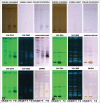Phytochemicals of Aristolochia tagala and Curcuma caesia exert anticancer effect by tumor necrosis factor-α-mediated decrease in nuclear factor kappaB binding activity
- PMID: 26792956
- PMCID: PMC4702274
- DOI: 10.4103/0976-0105.170585
Phytochemicals of Aristolochia tagala and Curcuma caesia exert anticancer effect by tumor necrosis factor-α-mediated decrease in nuclear factor kappaB binding activity
Abstract
Rationale: The active compounds or metabolites of herbal plants exert a definite physiological action on the human body and thus are widely used in human therapy for various diseases including cancer. Previous studies by our group have reported the anticarcinogenic properties of the two herbal plants extracts (HPE) of Aristolochia tagala (AT) Cham. and Curcuma caesia (CC) Roxb. in diethylnitrosamine-induced mouse liver cancer in vivo. The anticarcinogenic properties of these extracts may be due to the active compounds present in them.
Objectives: Our objective was to analyze the phytochemical constituents present in AT and CC, to assay their antioxidant properties and to determine their role in a possible intervention on tumor progression.
Materials and methods: Qualitative and quantitative analysis of constituent with anticancer properties present in the crude methanol extract of the two plants CC and AT was carried out following standard methods. Separation of the phytochemical compounds was done by open column chromatography. The extracts were eluted out with gradients of chloroform-methanol solvents. Ultraviolet-visible spectra of individual fractions were recorded, and the fractions were combined based on their λmax. The free radical scavenging activity of crude extracts and fractions obtained was also determined; the radical scavenging activity was expressed as IC50. High-performance thin layer chromatography (HPTLC) analysis of fractionated compounds was carried out to identify partially the phytochemical compounds. The anti-inflammatory and anticancer activity of AT and CC extracts was studied in DEN induced BALB/c mice by analyzing the tumor necrosis factor-α (TNF-α) levels in serum and the nuclear factor kappaB (NF-κB) binding activity in nuclear extracts of the liver.
Results: It was observed that both AT and CC contained compounds such as phenolics, tannins, flavonoids, terpenoids, etc., and both extracts exhibited antioxidant capacity. HPTLC analysis revealed the presence of phenolic compounds in CC and indicated the presence of anthocynidin 3-glycosides, 6-hydroxylated flavonols, some flavones and chalcone glycosides in AT and also confirmed the presence of compounds such as terpenes, phenols, steroids, and other organic compounds in CC and presence of flavonoids in AT. In vivo studies carried out in BALB/c mice showed that exposure to DEN caused an increase in TNF-α and NF-κB binding activity. The HPE (CC or AT) was seen to revert this effect.
Conclusions: The current paper documents the antioxidant, anti-inflammatory, and anticancer activity of the two extracts probably through TNF-α-mediated decrease in NF-κB binding activity. The active components of AT and CC may act as the potential anticancer agents in hepatocellular carcinoma and warrants further investigation.
Keywords: Antioxidant; Aristolochia tagala; Curcuma caesia; diethylnitrosamine; high performance thin layer chromatography; nuclear factor kappaB; tumor necrosis factor-α.
Figures





Similar articles
-
Inhibitory potential of methanolic extracts of Aristolochia tagala and Curcuma caesia on hepatocellular carcinoma induced by diethylnitrosamine in BALB/c mice.J Carcinog. 2014 May 30;13:7. doi: 10.4103/1477-3163.133520. eCollection 2014. J Carcinog. 2014. PMID: 25191135 Free PMC article.
-
In vitro Antioxidant Potential in Sequential Extracts of Curcuma caesia Roxb. Rhizomes.Indian J Pharm Sci. 2015 Jan-Feb;77(1):41-8. doi: 10.4103/0250-474x.151596. Indian J Pharm Sci. 2015. PMID: 25767317 Free PMC article.
-
Methanolic Extract of Curcuma caesia Roxb. Prevents the Toxicity Caused by Cyclophosphamide to Bone Marrow Cells, Liver and Kidney of Mice.Pharmacognosy Res. 2016 Jan-Mar;8(1):43-9. doi: 10.4103/0974-8490.171106. Pharmacognosy Res. 2016. PMID: 26941535 Free PMC article.
-
An updated review summarizing the anticancer potential of flavonoids via targeting NF-kB pathway.Front Pharmacol. 2025 Jan 6;15:1513422. doi: 10.3389/fphar.2024.1513422. eCollection 2024. Front Pharmacol. 2025. PMID: 39834817 Free PMC article. Review.
-
New Phenolics from Linum mucronatum subsp. orientale.Bioimpacts. 2014;4(3):117-22. doi: 10.15171/bi.2014.004. Epub 2014 Aug 19. Bioimpacts. 2014. PMID: 25337464 Free PMC article. Review.
Cited by
-
Aristolochia clematitis L. Ethanolic Extracts: In Vitro Evaluation of Antioxidant Activity and Cytotoxicity on Caco-2 Cell Line.Plants (Basel). 2024 Oct 25;13(21):2987. doi: 10.3390/plants13212987. Plants (Basel). 2024. PMID: 39519906 Free PMC article.
-
Biological Activities of Organic Extracts of the Genus Aristolochia: A Review from 2005 to 2021.Molecules. 2022 Jun 20;27(12):3937. doi: 10.3390/molecules27123937. Molecules. 2022. PMID: 35745061 Free PMC article.
-
Cytotoxic potential of Curcuma caesia rhizome extract and derived gold nanoparticles in targeting breast cancer cell lines.Sci Rep. 2024 Jul 26;14(1):17223. doi: 10.1038/s41598-024-66175-x. Sci Rep. 2024. PMID: 39060291 Free PMC article.
References
-
- Frenkel K. Carcinogen-mediated oxidant formation and oxidative DNA damage. Pharmacol Ther. 1992;53:127–66. - PubMed
-
- Fiorani M, Cantoni O, Tasinato A, Boscoboinik D, Azzi A. Hydrogen peroxide-and fetal bovine serum-induced DNA synthesis in vascular smooth muscle cells: Positive and negative regulation by protein kinase C isoforms. Biochim Biophys Acta. 1995;1269:98–104. - PubMed
-
- Fausto N. Mouse liver tumorigenesis: Models, mechanisms, and relevance to human disease. Semin Liver Dis. 1999;19:243–52. - PubMed
-
- Sethi G, Sung B, Aggarwal BB. TNF: A master switch for inflammation to cancer. Front Biosci. 2008;13:5094–107. - PubMed
-
- Balkwill F. Tumour necrosis factor and cancer. Nat Rev Cancer. 2009;9:361–71. - PubMed
LinkOut - more resources
Full Text Sources
Other Literature Sources
